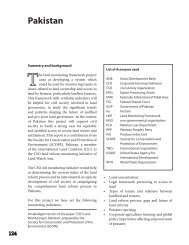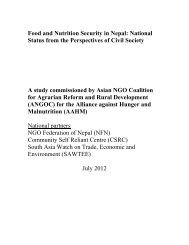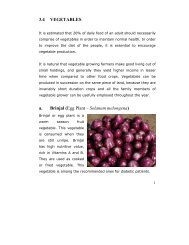Traditional Practices in Agriculture FULL - ANGOC Site
Traditional Practices in Agriculture FULL - ANGOC Site
Traditional Practices in Agriculture FULL - ANGOC Site
You also want an ePaper? Increase the reach of your titles
YUMPU automatically turns print PDFs into web optimized ePapers that Google loves.
6. Pieces of Palmura (Borassus flabellifer) leaves are tied on the<br />
poles fixed on the field, the sound produced by the leaves<br />
scares away the rats (also for birds scar<strong>in</strong>g).<br />
7. To reduce the population, rat holes are disturbed and rats<br />
are held at each harvest.<br />
8. Provid<strong>in</strong>g owl stands near the rat holes will help <strong>in</strong> reduc<strong>in</strong>g<br />
the rat damage.<br />
9. To catch the rats a trap made up of wire loops on bamboo<br />
pegs is used.<br />
10. Big round shaped earthen pots are buried on the field at<br />
ground level. Half of the pot is filled with mud slurry on<br />
which bait<strong>in</strong>g material is put on a coconut shell. Attracted<br />
rats fall <strong>in</strong>side the pot and they cannot climb up and get<br />
killed.<br />
11. Use of soaked rice as bait attracts more rats.<br />
12. Smok<strong>in</strong>g of rat burrows with paddy husk and dry chillies:<br />
Pungent smoke generated by paddy husk and chilies cause<br />
suffocation and kills rats. It is cost effective and eco-friendly<br />
measure for rat control.<br />
*****
















